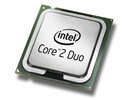Intel Core 2 Duo P7550 vs Intel Core 2 Duo P9700 vs Intel Core 2 Duo P8400
Intel Core 2 Duo P7550
► remove from comparisonDer Intel Core 2 Duo P7550 Dual-Core Prozessor bietet zwei Prozessorkerne mit einem gemeinsamen Level 2 Cache von 3 MB. Der P7550 ist baugleich zum Core 2 Duo P8400 und P7570, bietet jedoch keine Virtualisierungsfunktionen (VT-x) und keine Unterstützung für Trusted Execution Technology. Die Architektur des OEM Prozessors basiert auf den Penryn Kern und wird in 45nm gefertigt.
Für Multimediaanwendungen und anspruchslose Spiele, sollte die Performance des Intel Core 2 Duo P7550 ausreichen. Im Vergleich zu AMD sollte die Performance auf Niveau der schnellsten Turion II Ultra mit 2.4 - 2.6 GHz liegen. Anspruchsvolle Spielefans sollten jedoch eher zu höher getakteten Core 2 Duo CPUs greifen (>2.5 GHz).
Der Penryn (Montevina Update) Kern bietet 2 Integer Units, 1 Floating Point Unit, 1 Load Unit und 1 Store Unit in einer 14-stufigen Pipeline. Mit der Wide Dynamic Execution Technologie kann der Kern bis zu vier volle Instruktionen gleichzeitig ausführen.
Dank Dynamic Acceleration (später Turbo Modus genannt), kann sich ein Kern um eine Stufe übertakten, wenn der zweite im Idle Modus (Leerlauf) ist.
Das integrierte Enhanced Speedstep kann die Taktfrequenz des Prozessors dynamisch an die Leistungsanforderungen anpassen. Dadurch läuft die CPU ohne Last nur mit 800 MHz.
Intel Core 2 Duo P9700
► remove from comparison
Der Intel Core 2 Duo P9700 ist ein schneller und trotzdem sparsamer Doppelkernprozessor der Penryn Reihe für Notebooks. Die CPU ist die schnellste Variante der Core 2 Duo P-Serie, braucht jedoch mit 28 Watt etwas mehr Strom als die kleineren P-Modelle. Im Vergleich zur T-Serie (welche mit 35 Watt spezifiziert ist), ist der P9700 jedoch sparsam.
Die Performance des Core 2 Duo P9700 ist vergleichbar mit dem ebenfalls mit 2.8 GHz getakteten Core 2 Duo T9600 und dadurch sollte sie für die alle Spiele in 2009 ausreichen (nur GTA 4 profitiert deutlich von mehr Prozessorkernen). Die alten Core 2 Quad Mobilprozessoren (Q9000, QX9300) werden dank der hohen Taktung des P9700 bei den meisten Spielen geschlagen (da Spiele aus 2009 meist nicht mehr als 2 Kerne auslasten).
Der Penryn (Montevina Update) Kern bietet 2 Integer Units, 1 Floating Point Unit, 1 Load Unit und 1 Store Unit in einer 14-stufigen Pipeline. Mit der Wide Dynamic Execution Technologie kann der Kern bis zu vier volle Instruktionen gleichzeitig ausführen.
Dank Dynamic Acceleration (später Turbo Modus genannt), kann sich ein Kern um eine Stufe übertakten, wenn der zweite im Idle Modus (Leerlauf) ist.
Das integrierte Enhanced Speedstep kann die Taktfrequenz des Prozessors dynamisch an die Leistungsanforderungen anpassen.
Intel Core 2 Duo P8400
► remove from comparison
Der Intel Core 2 Duo P8400 Dual-Core Prozessor bietet zwei Prozessorkerne mit einem gemeinsamen Level 2 Cache von 3 MB. Im Vergleich zu den stärkeren Modellen bietet, der P8400 zwar nur die Hälfte an Level 2 Cache, jedoch bleibt dadurch der Stromverbrauch mit maximal 25 Watt auch geringer. Die Architektur des Prozessors basiert auf den Penryn Kern und wird in 45nm gefertigt.
Der P8400 ist sehr ähnlich zu der OEM Version Core 2 Duo P7550, welcher später auf den Markt kam.
Für Multimediaanwendungen und anspruchslose Spiele, sollte die Performance des Intel Core 2 Duo P8400 ausreichen. Im Vergleich zu AMD sollte die Performance auf Niveau der schnellsten Turion II Ultra mit 2.4 - 2.6 GHz liegen. Anspruchsvolle Spielefans sollten jedoch eher zu höher getakteten Core 2 Duo CPUs greifen (>2.5 GHz).
Der Penryn (Montevina Update) Kern bietet 2 Integer Units, 1 Floating Point Unit, 1 Load Unit und 1 Store Unit in einer 14-stufigen Pipeline. Mit der Wide Dynamic Execution Technologie kann der Kern bis zu vier volle Instruktionen gleichzeitig ausführen.
Dank Dynamic Acceleration (später Turbo Modus genannt), kann sich ein Kern um eine Stufe übertakten, wenn der zweite im Idle Modus (Leerlauf) ist.
Das integrierte Enhanced Speedstep kann die Taktfrequenz des Prozessors dynamisch an die Leistungsanforderungen anpassen. Dadurch läuft die CPU ohne Last nur mit 800 MHz.
Der Core 2 Duo P8400 passt in den Socket P (mit 479 Pins):
Socket P / Micro Flip-Chip Pin Grid Array (Micro-FCPGA) requires 479-pin surface mount Zero Insertion Force (ZIF) socket (mPGA479M socket) or Micro Flip-Chip Ball Grid Array (Micro-FCBGA) for surface mount (479-ball)
Benchmarks
Average Benchmarks Intel Core 2 Duo P7550 → 100% n=10
Average Benchmarks Intel Core 2 Duo P9700 → 128% n=10
Average Benchmarks Intel Core 2 Duo P8400 → 104% n=10
* Smaller numbers mean a higher performance
1 This benchmark is not used for the average calculation













